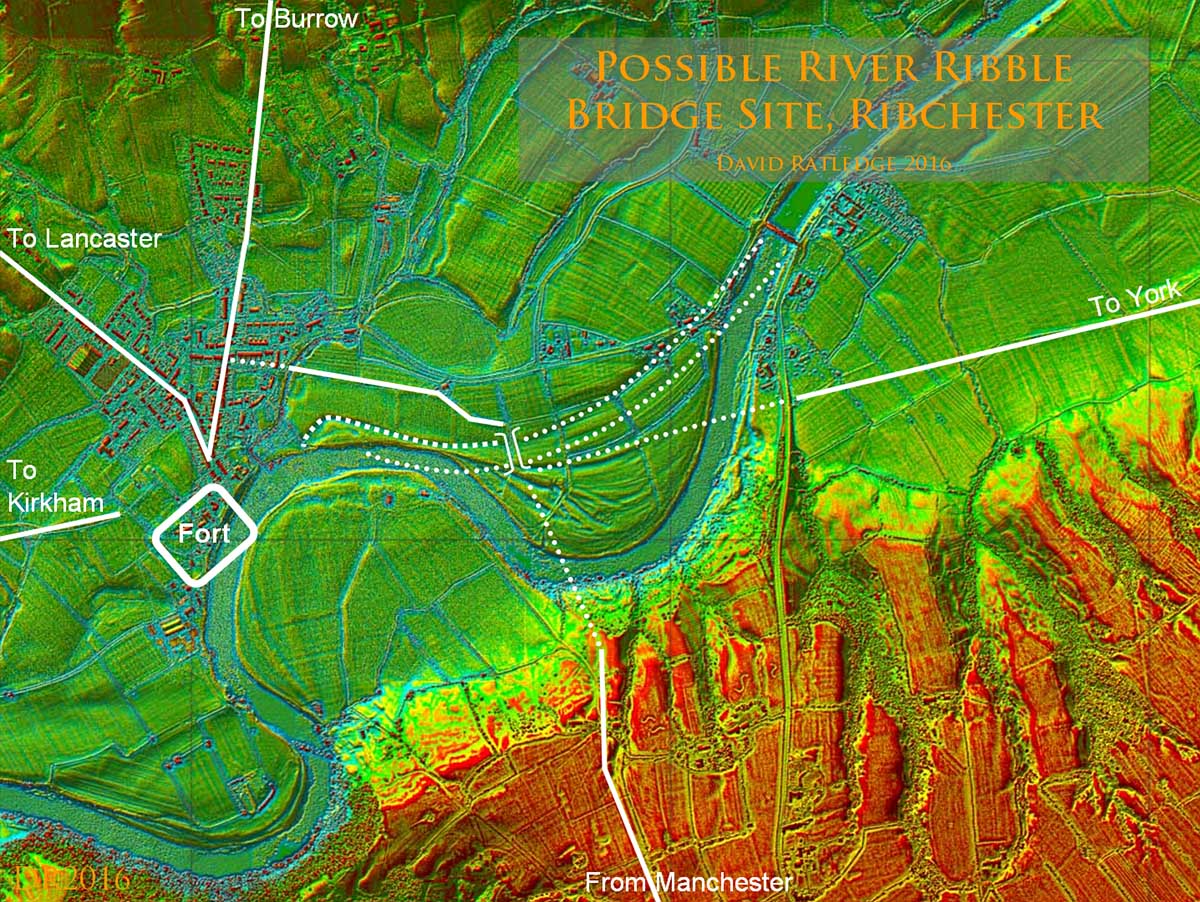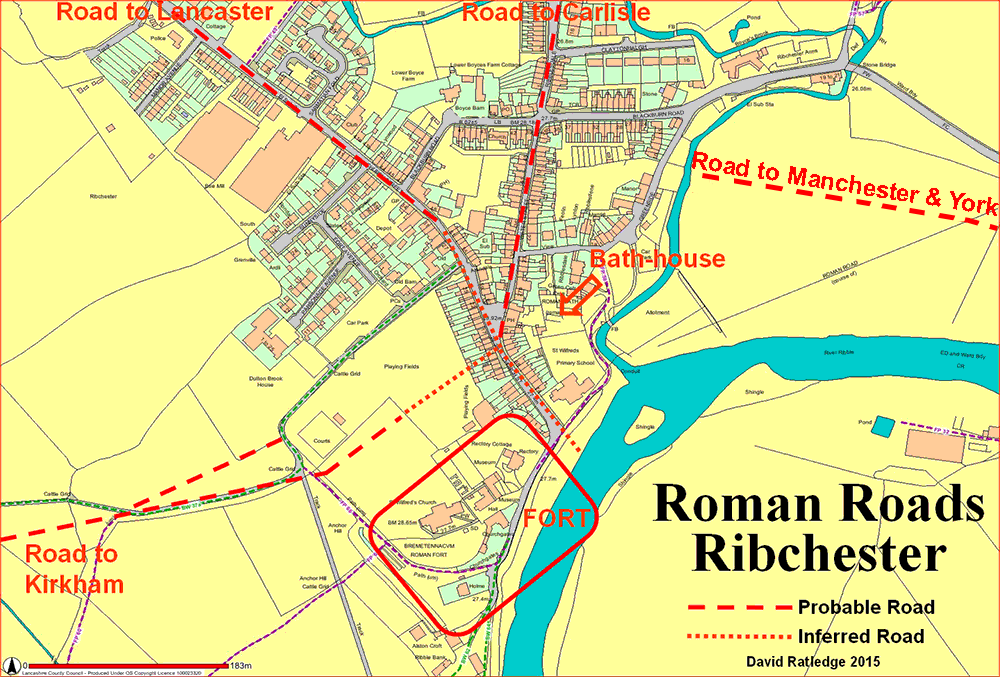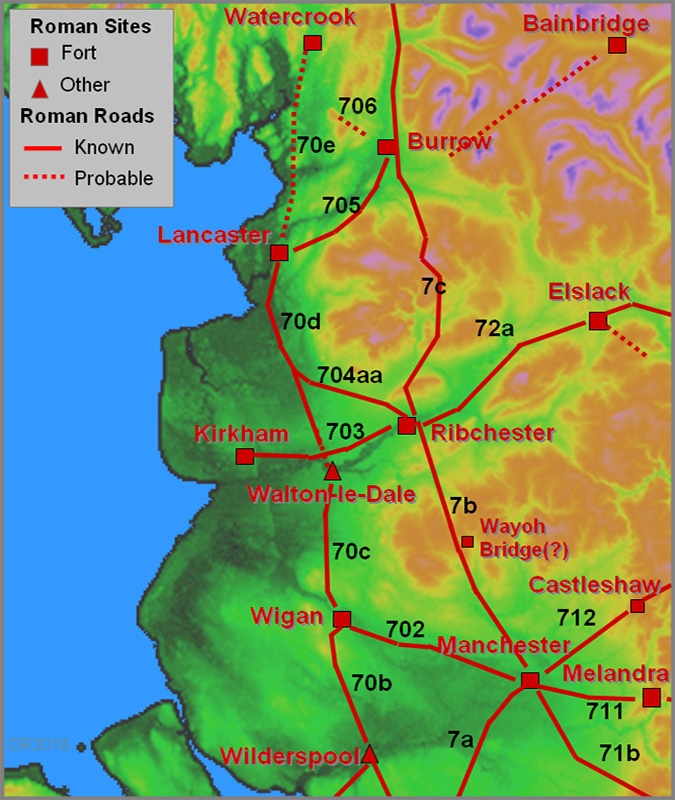
|
The Roman Road from Manchester to RibchesterMargary Number: 7bDistance: 26.5 milesConsidered by many to be the original Roman route north linking two of our most important forts. As we shall see below there was almost certainly an intermediate fort splitting the distance almost in two. A feature of the road is the use of long sighting alignments - indicative of military planning no doubt. The first alignment is on Affetside, the second on Rushton's Height, the third on Top of Ramsgreave and the final one, not on Ribchester, but on Jeffrey Hill. We now have some evidence as to where the first alignment was set out at the Manchester end. |
Historic County: Lancashire Current Counties: Greater Manchester & Lancashire HER: Greater Manchester & Lancashire
|
|
|
|
|
|
Lidar Plan - Wayoh Bridge Fort LiDAR has provided that positive conclusion and clearly visible is the probable outline of a small fort with double ditches on 3 sides, single ditch on the road side and 3 rounded corners. The Roman road from Manchester to Ribchester passes the fort on its south-west side and the fort's location on a headland before the descent to Wayoh Bridge is an excellent one. It has superb views both north and south along the Edgworth Valley. The site lies approximately 14 miles from Manchester and 12 miles from Ribchester making it a logical location. There are traces in the LiDAR data of an internal feature (building?) that respects the orientation of the fort. Also noticed was a water supply for the fort coming down alongside Moorside Road. |
Click for larger view |
 |
OS Map - Wayoh Bridge Fort The features visible in the Lidar have been transferred to the latest OS Map courtesy of Lancashire CC Mario
|
Click for larger view |
 |
Wayoh Bridge Fort - South-West Corner Visits to the site have confirmed its suitability for a fort with the ditches evident and 3 of the rounded corners detectable. Often with LiDAR finding the features on the ground can be difficult but not here. The fort platform measures in the order of 75 metres square and could be described as either a fortlet or small fort. The double ditches are perhaps a bit unusual and could indicate two phases with a later reduction in size - possibly similar to Castleshaw which also lies at a very similar distance from Manchester (13 miles). There are traces in the LiDAR data of an internal feature (building?) that respects the orientation of the fort - see the LiDAR plan. Also noticed was a water supply for the fort coming down alongside Moorside Road.
|
Click for larger view |
 |
Wayoh Bridge Fort - Southern Ditches and Rampart The ditches on the south side are the easiest to find on the ground and the rise up to what must be the south rampart is even more obvious. The double ditches are perhaps a bit unusual as they are somewhat widely space. This could indicate two phases with a later reduction in size - possibly similar to Castleshaw which also lies at a very similar distance from Manchester (13 miles).
|
Click for larger view |
 |
3D Lidar Video Flyover - Edgworth and Wayoh Bridge Fort
|
||
Roman Road Route Map - Walves Reservoir to Pike House Lidar shows the road continuing west of Blackburn road north of Wayoh Bridge before merging in the modern road at Pike House. |
Click for larger view |
 |
3D Oblique Lidar Image - Grimehills Bridge looking north to Rushtons Height The Ordnance Survey first edition show the Roman road heading straight at Grimehills Bridge but on close study I think the modern road probably marks its actual course. Beyond Grimehills Bridge the modern road wanders off the Roman line on its east side for a short spell. At Rushtons Height at the top of the image, the road will make another turn onto the next alignment aiming for the Top of Ramsgreave.
|
Click for larger view |
 |
Blacksnape, Nr Rushtons Height - looking North It needs a very clear day to prove it but these long setting-out alignments were perfectly feasible. The final alignment change at Top of Ramsgreave is exaggerated in this telephoto shot - the actual angle change is only 1 degree for Jeffrey Hill. I have shown the line as straight on the photo but there is Lidar evidence that the Roman line could well be slightly further to the left (west) here on a line through the Red Lion Inn (cream gable ended building). There is a local folklore that the road is visible in the cellar. The Roman alignment leaves the modern Blackburn Road at Hoddlesden Road. In July 2005, Darwen Archaeological Society excavated to try and find the road at Brocklehead Farm but were unlucky. Lidar indicates the road is in the recorded position but has been much disturbed and removed in several places.
|
Click for larger view |
 |
Top of Ramsgreave - looking South Looking back to where the previous photo was taken. Blackburn lies out of sight over the hill with the church tower. This is the first visible trace north of Blackburn with agger showing as a lighter shade of grass. What also is evident is how big it is - this was a major Roman highway.
|
Click for larger view |
 |
Top of Ramsgreave - looking North Ribchester is down in the valley bottom but the road is aligned on Jeffrey Hill now. It can be made out by a series of hedgerows most of the way to Jeffrey Hill. Note: Jeffrey Hill can also be spelt Jeffry. |
Click for larger view |
 |
Possible River Ribble Bridge - Ribchester The site of the Roman bridge at Ribchester over the River Ribble has been the subject of much speculation. With the advent of Lidar we can now make an informed guess at to where it could well have been located. The route of the road down to the Ribble valley from Manchester and that of the road to York are visible in the Lidar data giving strong clues as to the bridge's possible location. Also visible is the probable linking road from Ribchester near Beech House. Note there is no evidence for the road from Manchester bypassing Ribchester and continuing on towards Jeffrey Hill. To get to Jeffrey Hill and the north then a diversion into Ribchester was evidently necessary. Despite these clear indication of the roads approaching the bridge site, the big unknown remained - where precisely was the river? Clearly is has moved over the centuries - witness the destruction of around 1/3rd of the fort itself. However, also visible in Lidar are earlier courses of the river, perhaps those dating from Roman times. Given that the roads would have been aligned on the bridge then its position can be surmised and a probable location for the Roman Bridge (see right). Given the southwards movement of the river, then the northern abutment would represent the best chance for survival. But would there be any supporting evidence on the ground?
|
Click for larger view |
 |
Lidar Image - link road to Ribchester at Beech House Fortunately, in December 2016, the opportunity arose during a watching brief at Beech House to explore the possible bridge locations. Thanks are due to Nigel Neil and the landowner Mr Paul for their help and assistance. There were traces of an agger at two spots and where the bridge approach was surmised there was a large assemblage of stones including one dressed sandstone block. There were none elsewhere. Does one dressed stone make a bridge? Probably not but it is a logical position for a bridge bearing in mind the alignment of the roads and the possible old river course there. The coordinates of the possible bridge's north abutment would be SD6566 3522. |
Click for larger view |
 |
Looking East towards the possible bridge location, East of Beech House The agger is very obvious and definite here but it doesn't aim for the bridge abutment. This at first may seem strange but for there would have to have been an approach ramp to get up to bridge deck level. So the stone area would not represent the actual bridge just its approach. The bridge abutment would by alongside the river channel.
|
Click for larger view |
 |
Ribchester Roman Road Map We can now complete a Roman road map of Ribchester with reasonable confidence. The original fort was further north than the later stone fort and the road layout was clearly designed/set out for the first fort. Disregard the Ordnance Survey line shown on the map for the road to the east. |
Click for larger view |
 |
|
|
|
Last update: April 2018 |
© David Ratledge |
















